Pandoro (Italian Christmas Cake)
This post may contain affiliate links. See my disclosure policy.
The famous star-shaped Christmas cake from Verona, Italy! This traditional pandoro recipe takes some time to make but the effort is well worth it to enjoy this delicate vanilla-infused cake-like bread with its beautiful appearance, delicious flavor, and wonderful texture!
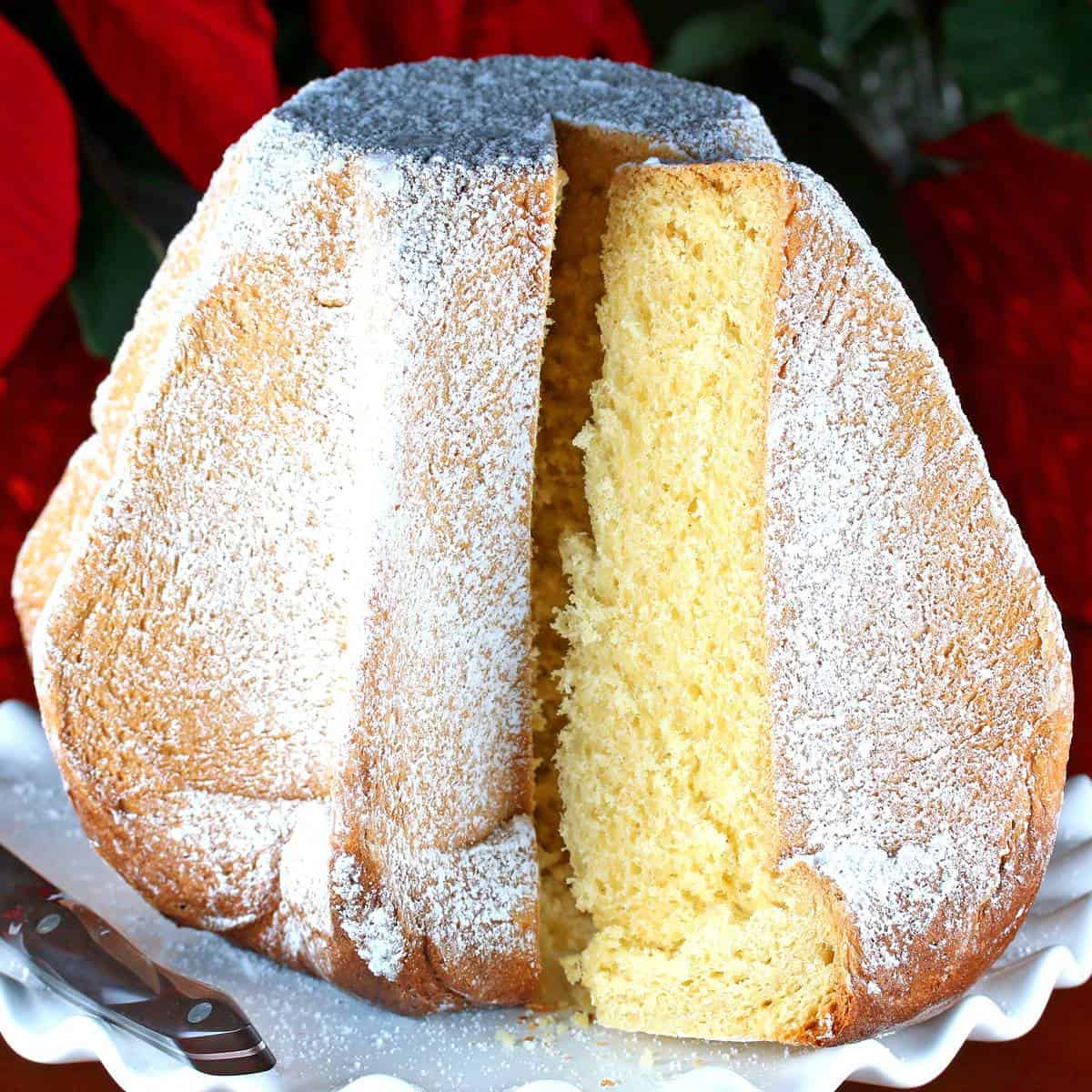
What is Pandoro?
Pandoro, translated as “golden bread”, is an Italian vanilla-infused sweet bread or cake that is baked in a special 8-pointed star-shaped pan giving it its famous appearance. It’s traditionally dusted with confectioner’s sugar to resemble the snow-covered peaks of the Italian Alps near Verona, the town where pandoro originated, and is most popular during the Christmas holidays and New Year’s.
Pandoro is considered the descendent of the earlier Nadalin, a sweetened bread that is a flatter and irregular-shaped star made with simpler ingredients and much simpler to make. Pandoro was created in the late 1800’s and is attributed to a local baker in Verona named Domenico Melegatti who was bestowed by royal decree a 3 year exclusive right to produce the cake. His cake-like bread was made with generous amounts of egg yolks, butter, and honey/sugar, and became immediately popular among the rich and noble where it was coined “bread of gold.” It’s said that some nobility even served it covered in gold leaf. Melegatti trademarked his famous cake in 1894 and today the brand still sold today.
In addition to its unique shape, pandoro is known for its yellow color which is gets from the egg yolks. The darker the egg yolks the richer the yellow.
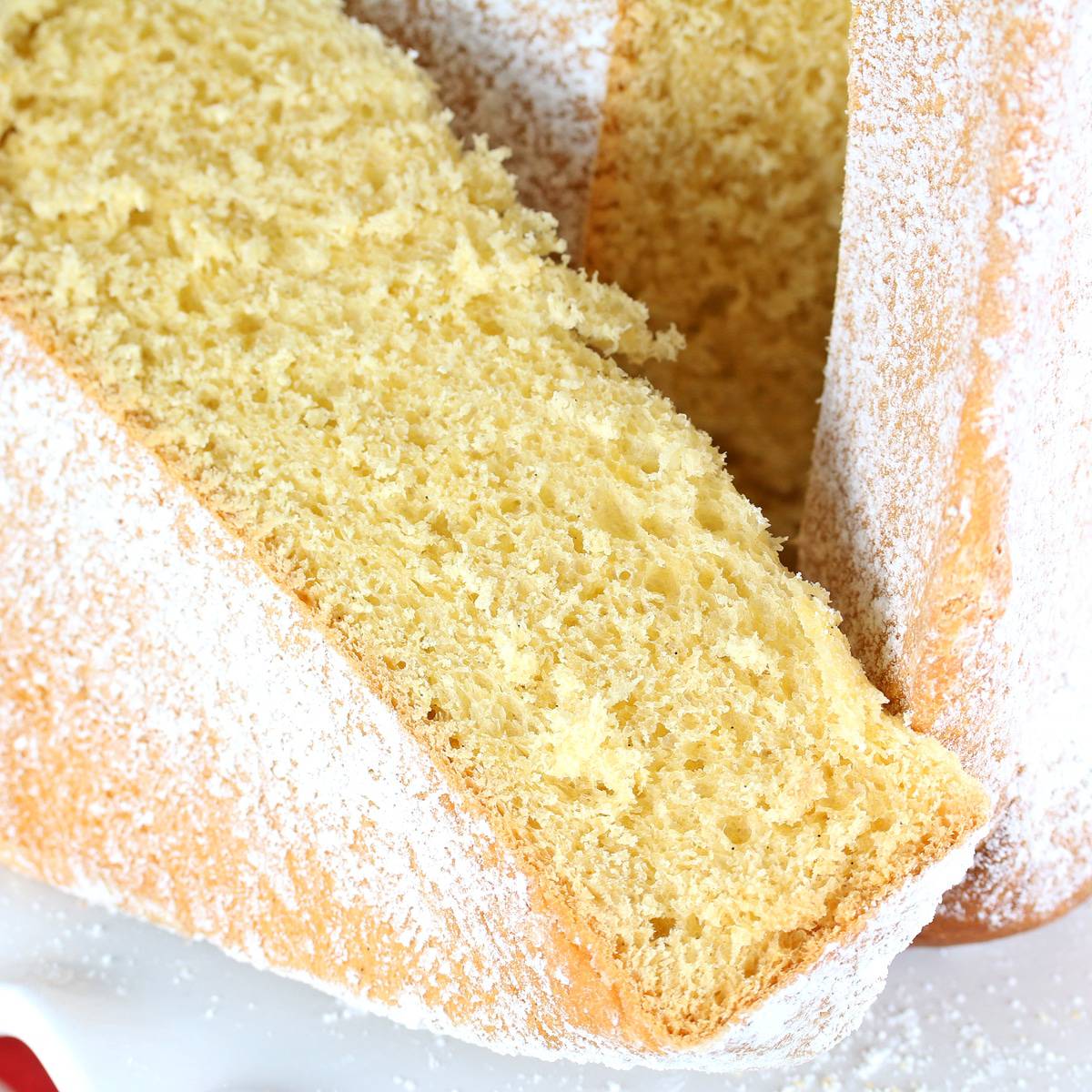
How Do You Serve Pandoro?
In its simplest and traditional form it is served with a generous dusting of powdered sugar.
But today you can find it served with a variety of creams or sauces such as mascarpone, zabaglione, vanilla custard, sweetened whipped cream, and even covered in chocolate.
It is commonly enjoyed with a warm beverage.
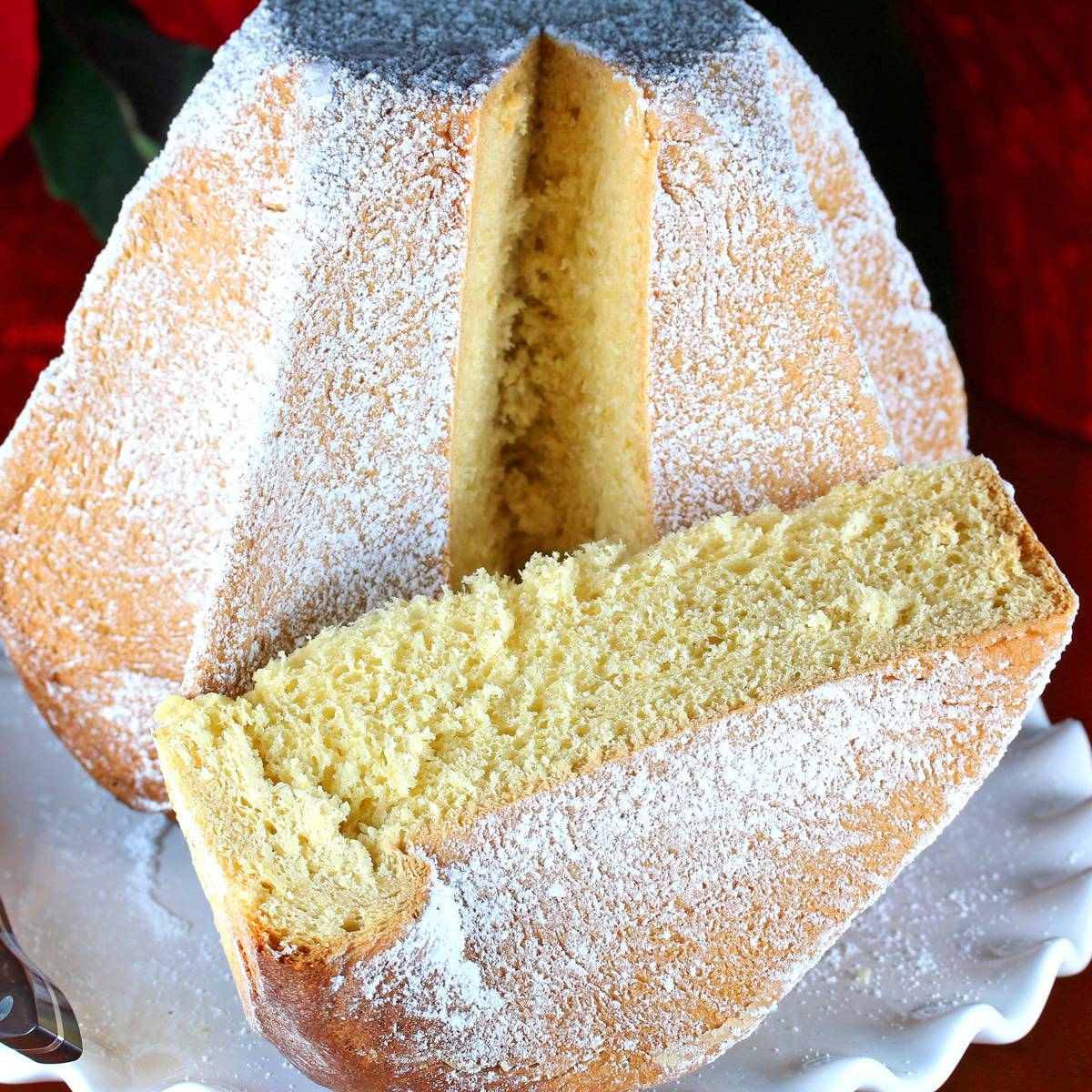
Panettone vs. Pandoro – What is the Difference?
Two of the most popular Italian traditions during the Christmas season are panettone and pandoro. Both are enriched sweet breads but their differences lie in both their appearance as well as ingredients. Panettone is a kind of fruit cake made with raisins and candied citrus peel while pandoro contains neither and is a much simpler sweet bread.
Both breads have a very passionate – and divided – following. You could say these breads are arch rivals and that rivalry runs deep. You’ll have to decide for yourself where your loyalties lie. I say why choose? Make both!
Get my recipe for traditional Panettone.
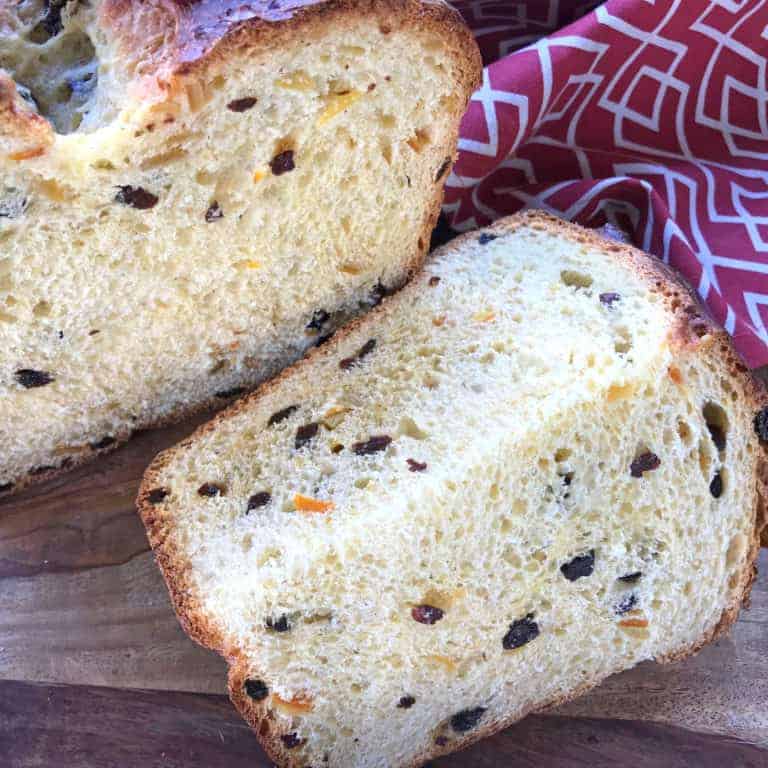
The ingredients in pandoro are simple and as such it’s imperative to use the best quality ingredients you can find.
To make this the traditional way takes time. But the time and effort is well worth it. The flavor is delicate and the texture is fabulous.
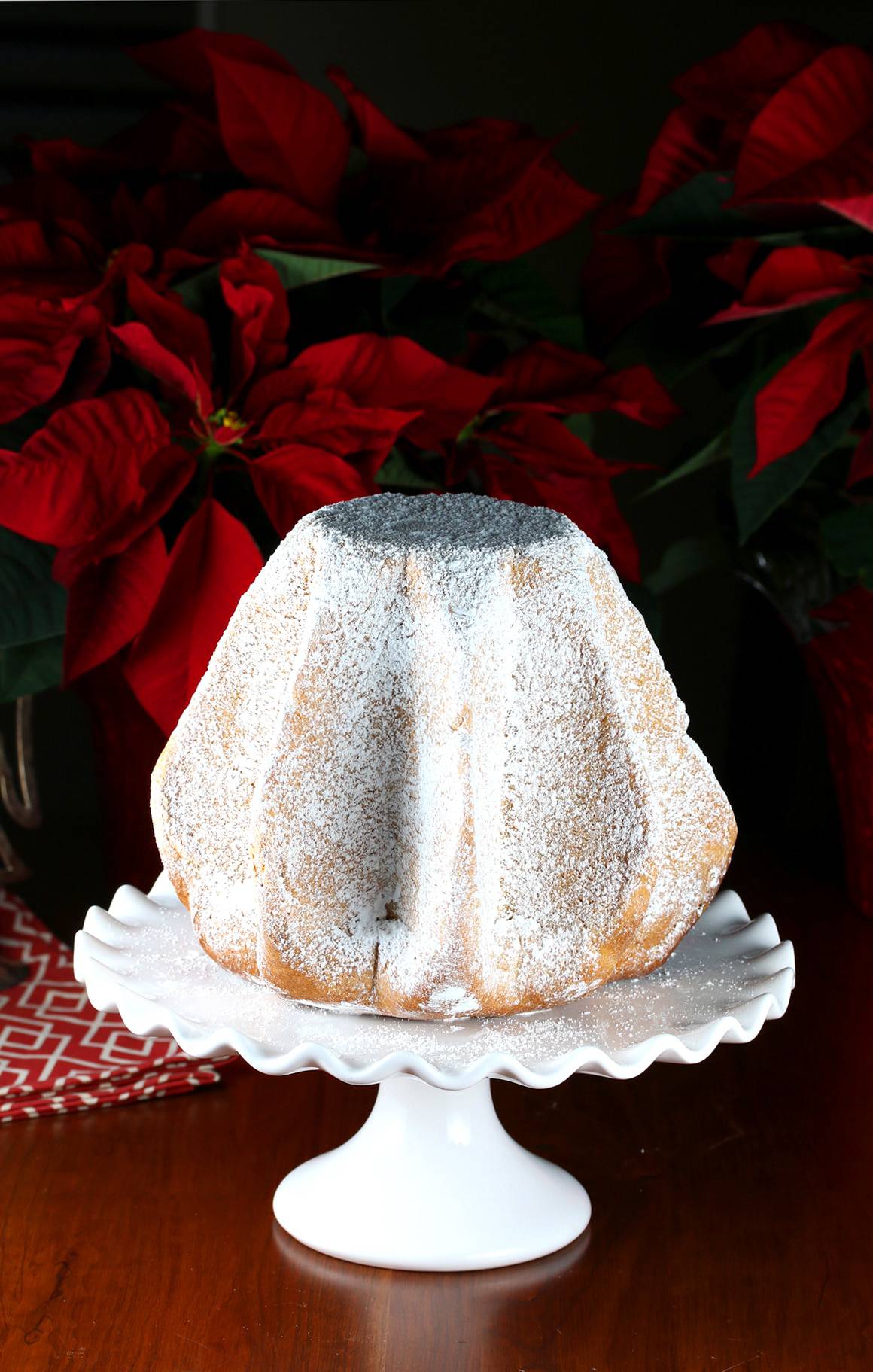
Pandoro Recipe
Let’s get started!
You’ll need the special 8-pointed star-shaped pan. These are not the easiest to find but you can find them online such as here on Amazon. Alternatively, you can use a half-size mold to make two smaller ones or you can halve the recipe and just make one smaller one.
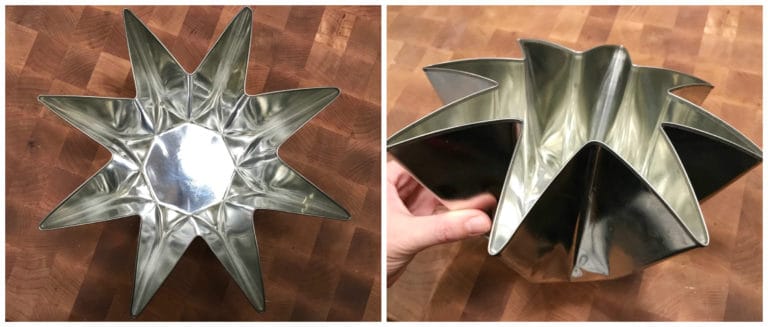
To make the starter dough: Dissolve the yeast and sugar in the lukewarm water and let it sit for 10-15 minutes until nice and frothy. Place the flour and salt in the bowl of a stand mixer and add the yeast mixture. Using the dough hook, knead the ingredients until they come together. The dough will be smooth but firm and stiff.
Form the dough into a ball, place it in a lightly greased bowl, cover loosely with plastic wrap, and let it rise in a warm place for about 2 hours or until nearly doubled in size.
Punch it down, form it into a ball, place it back in the bowl, cover tightly with plastic wrap, and place it in the fridge to sit overnight. **Remove the dough from the fridge the next day 2 hours before you’re ready to proceed with making the pandoro.
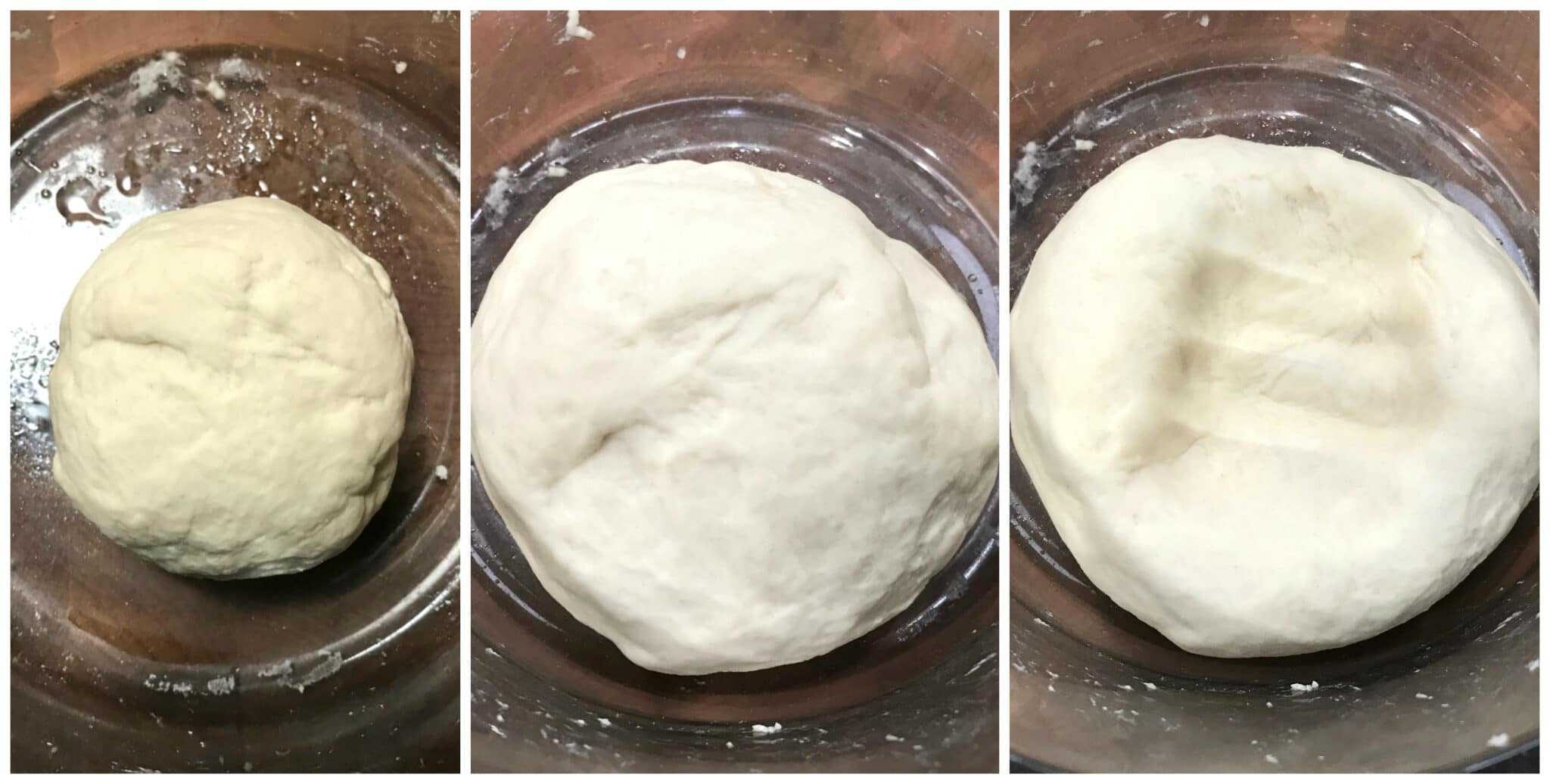
The next day dissolve the yeast and sugar in the lukewarm milk and let it sit for 10-15 minutes until nice and frothy.
Place the flour, sugar, and yeast mixture in the bowl of a stand mixer and mix it together with spoon or with the dough hook.
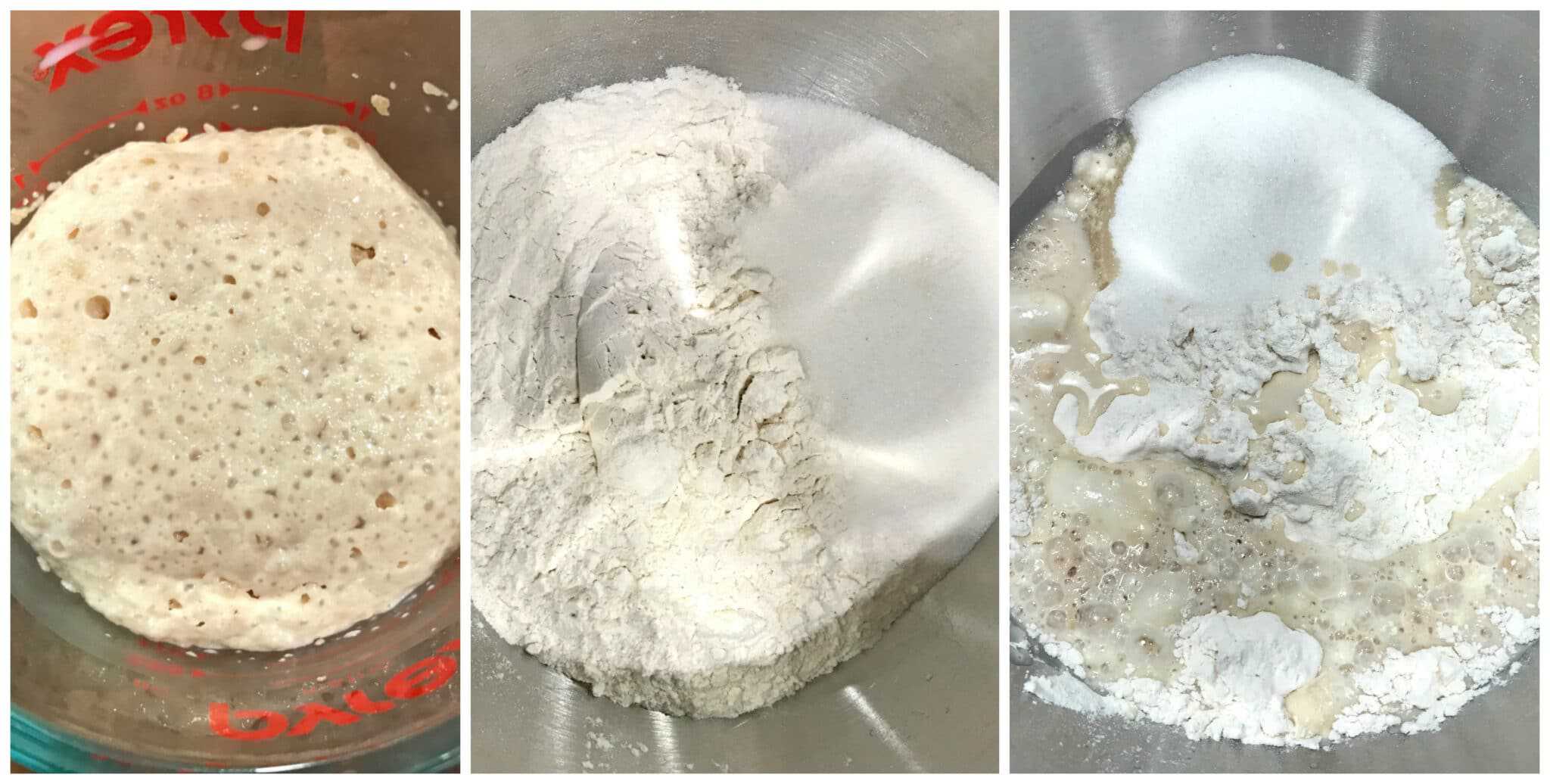
Using the dough hook, add the eggs one at a time, kneading between additions.
The mixture will come together into a rich yellow dough.
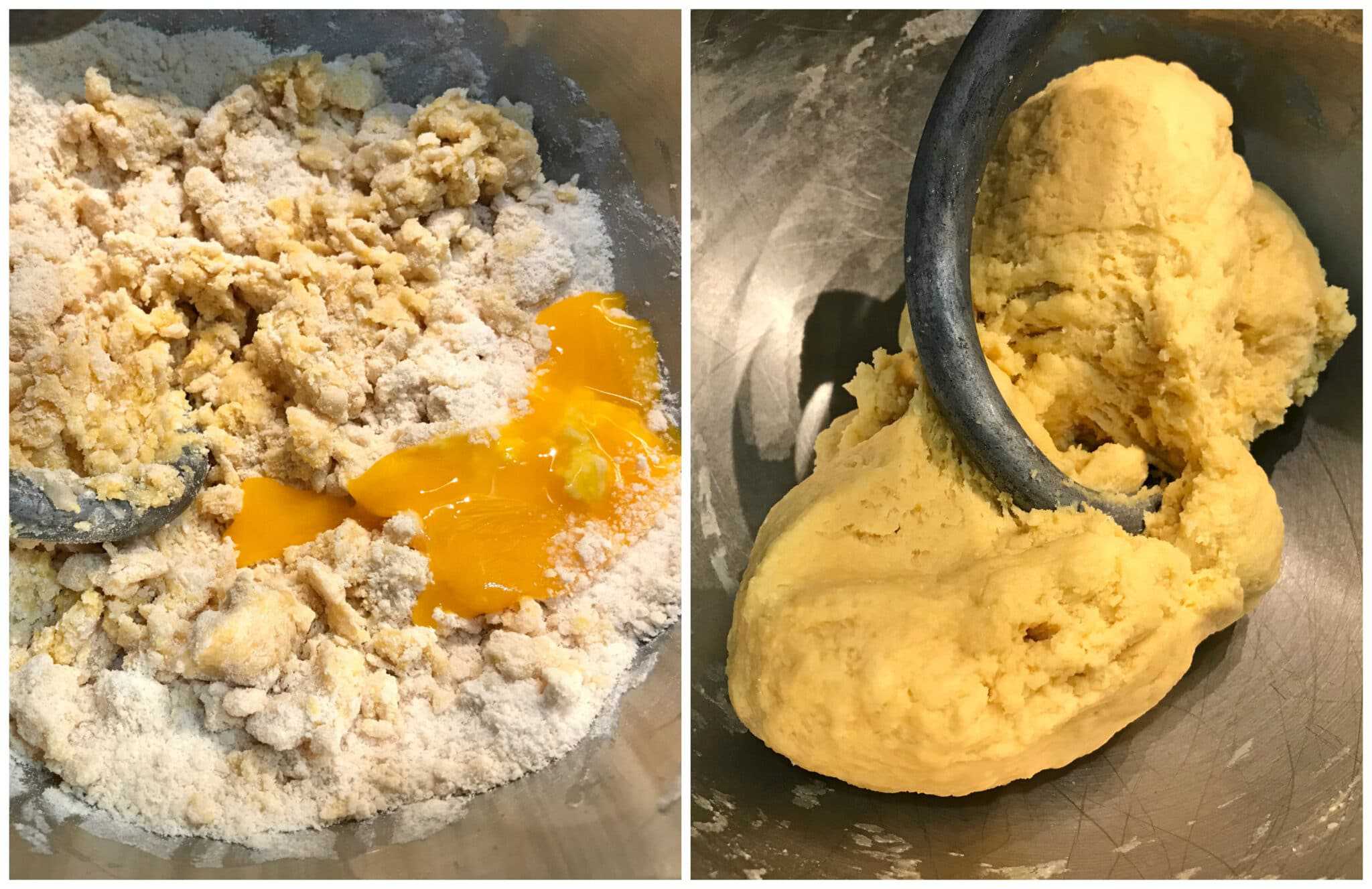
Add the starter dough to the stand mixer.
Knead the two doughs together for about 5 minutes.
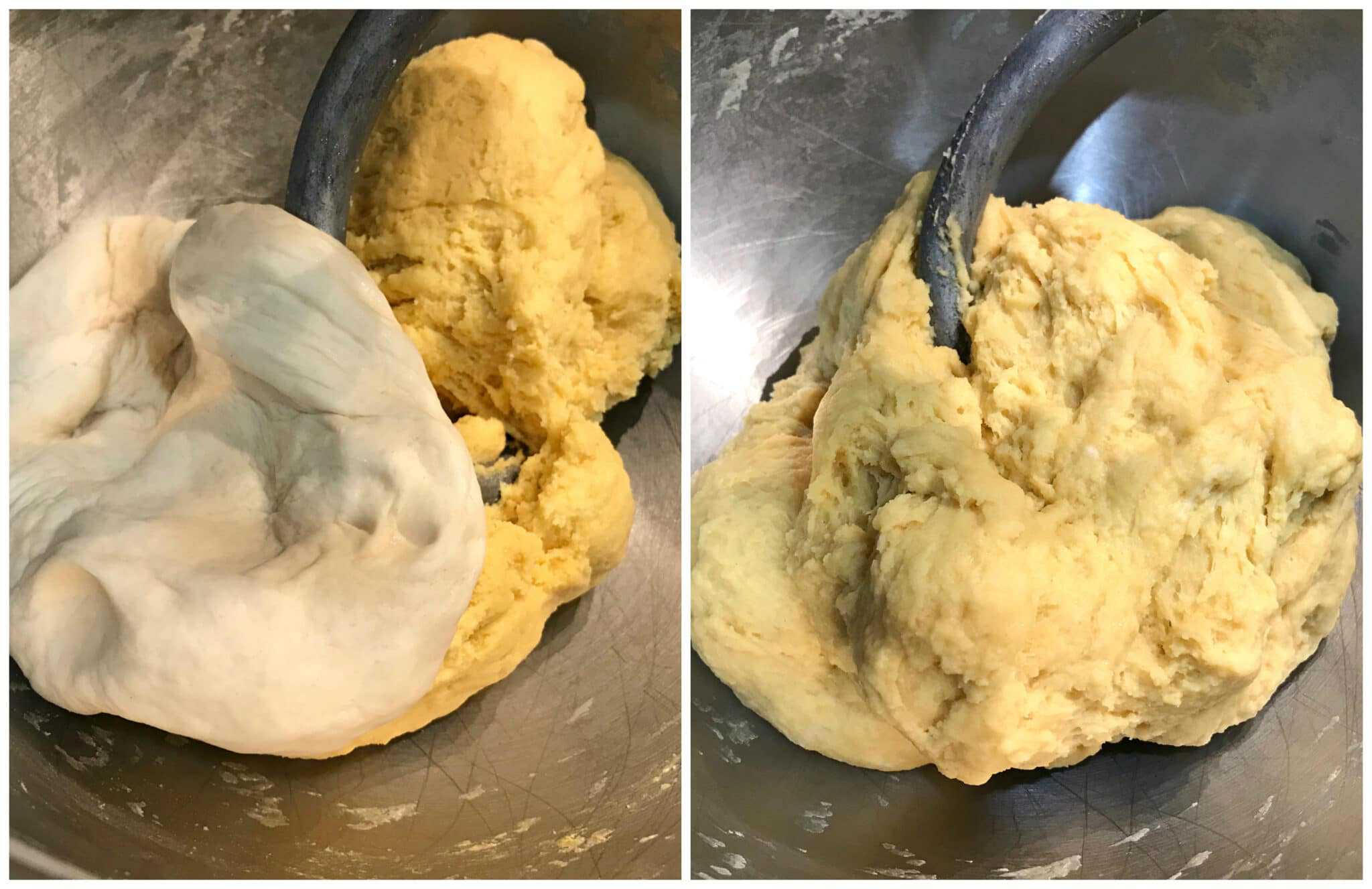
Add the butter, lemon zest, vanilla, and honey and knead for about 10 minutes, scraping down the sides of the bowl as needed. Add 2 tablespoons of flour.
The dough should be very smooth and elastic but not overly sticky. If it’s too sticky add a little more flour.
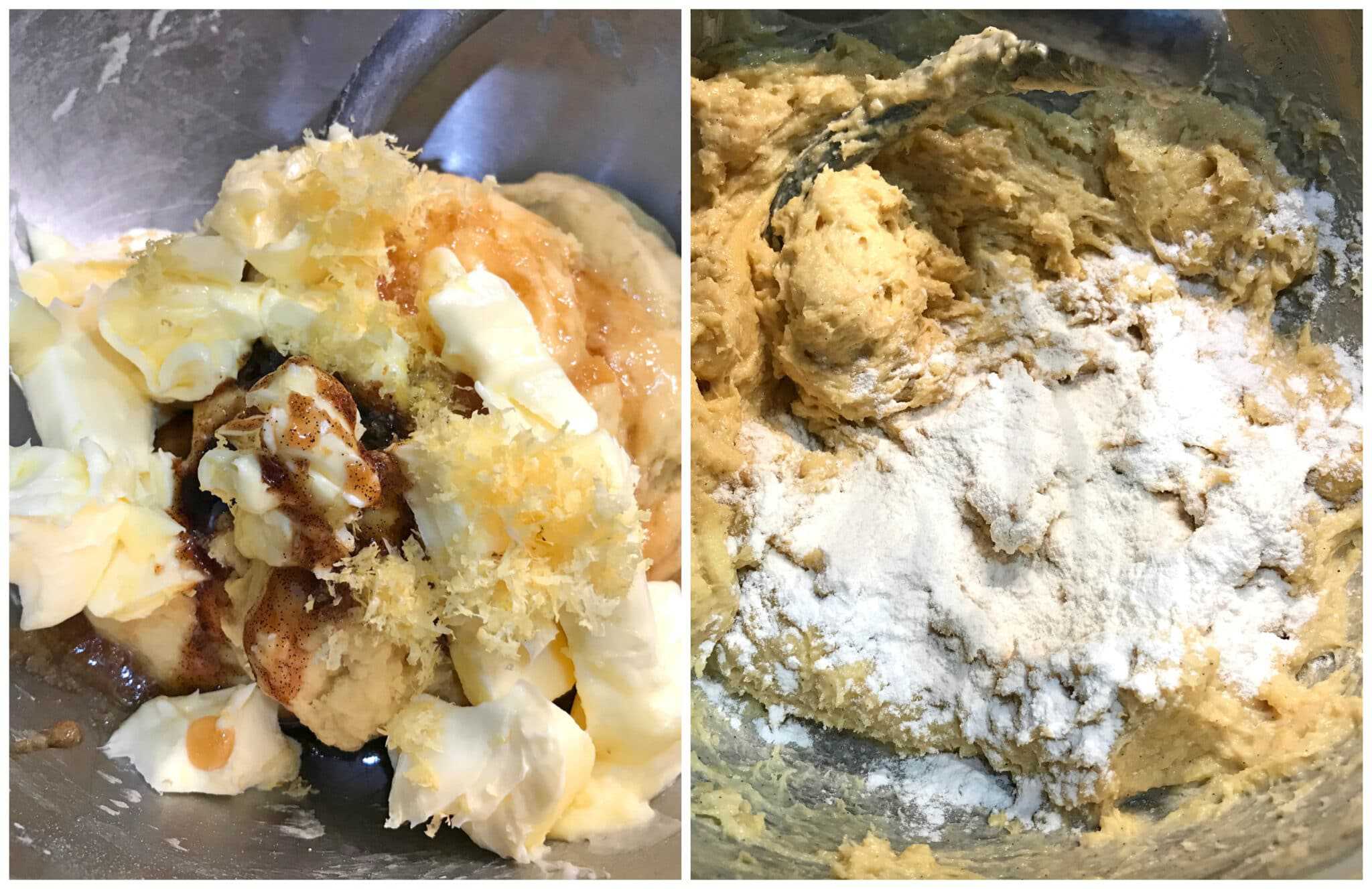
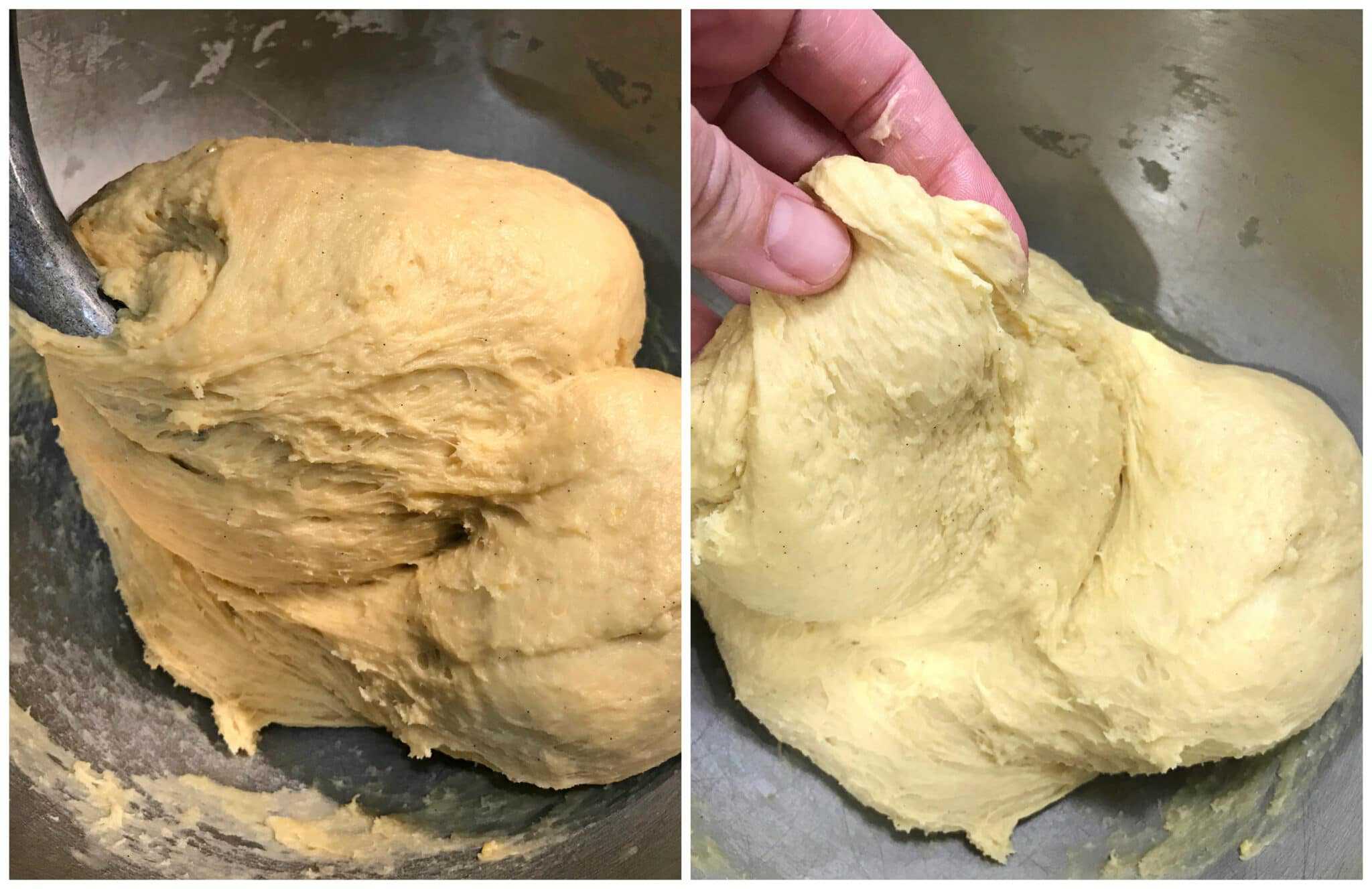
Form the dough into a ball, lightly spray the bowl, and place the dough back in, loosely covered with plastic wrap, to rise in a warm place for about 3 hours or until nearly tripled in size. Punch the dough down.
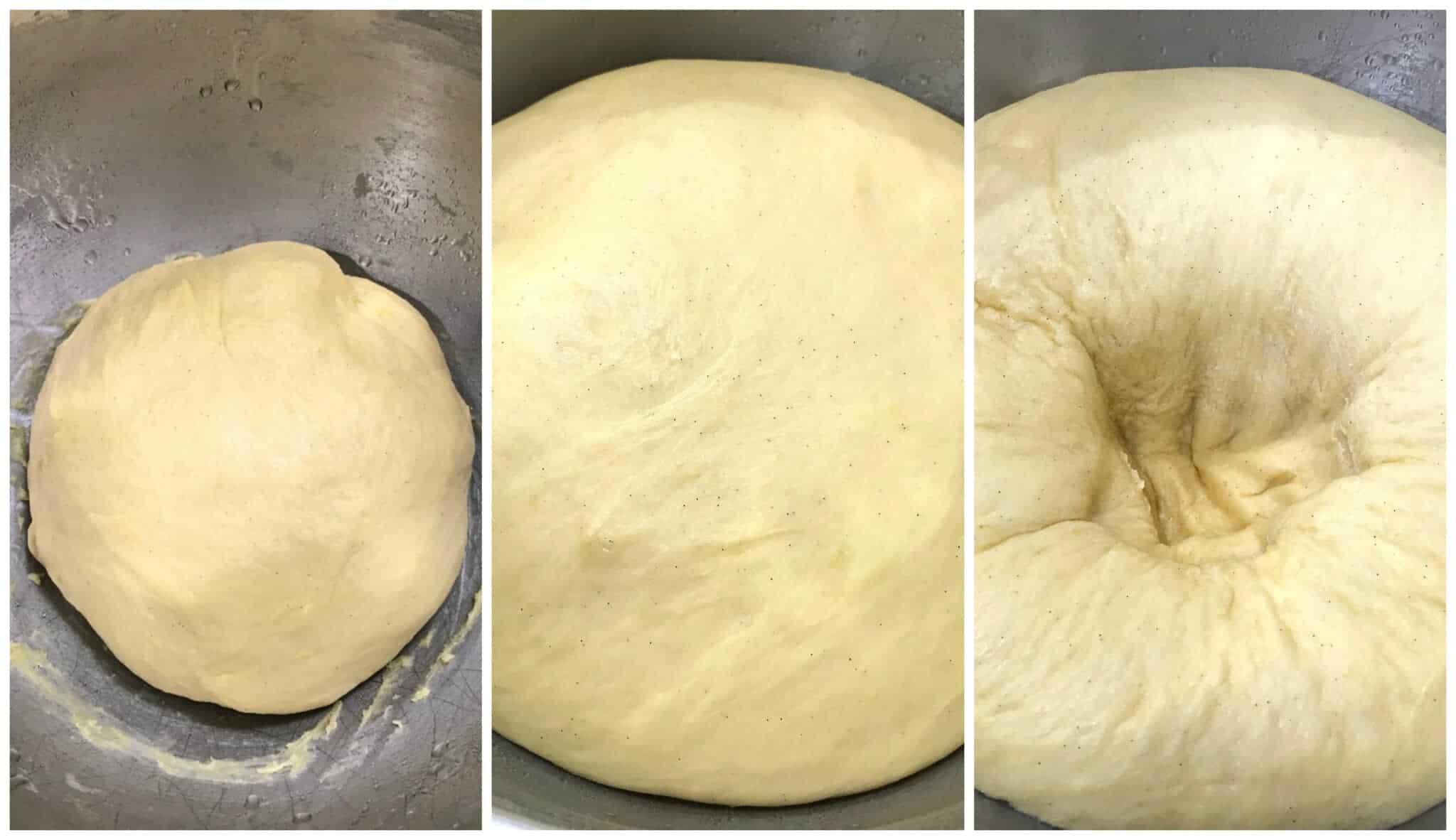
Generously butter the pan, getting into all the cracks and crevices.
Next add some flour to the pan and shake it to thoroughly coat it with flour, shaking out the excess flour. Again, be sure to get into all the cracks and crevices so that your pandoro doesn’t stick to the pan.

Place the dough into the prepared pandoro mold.
Cover loosely with plastic wrap and let it rise in a warm place until the dough has risen to about an inch or so above the top of the mold.
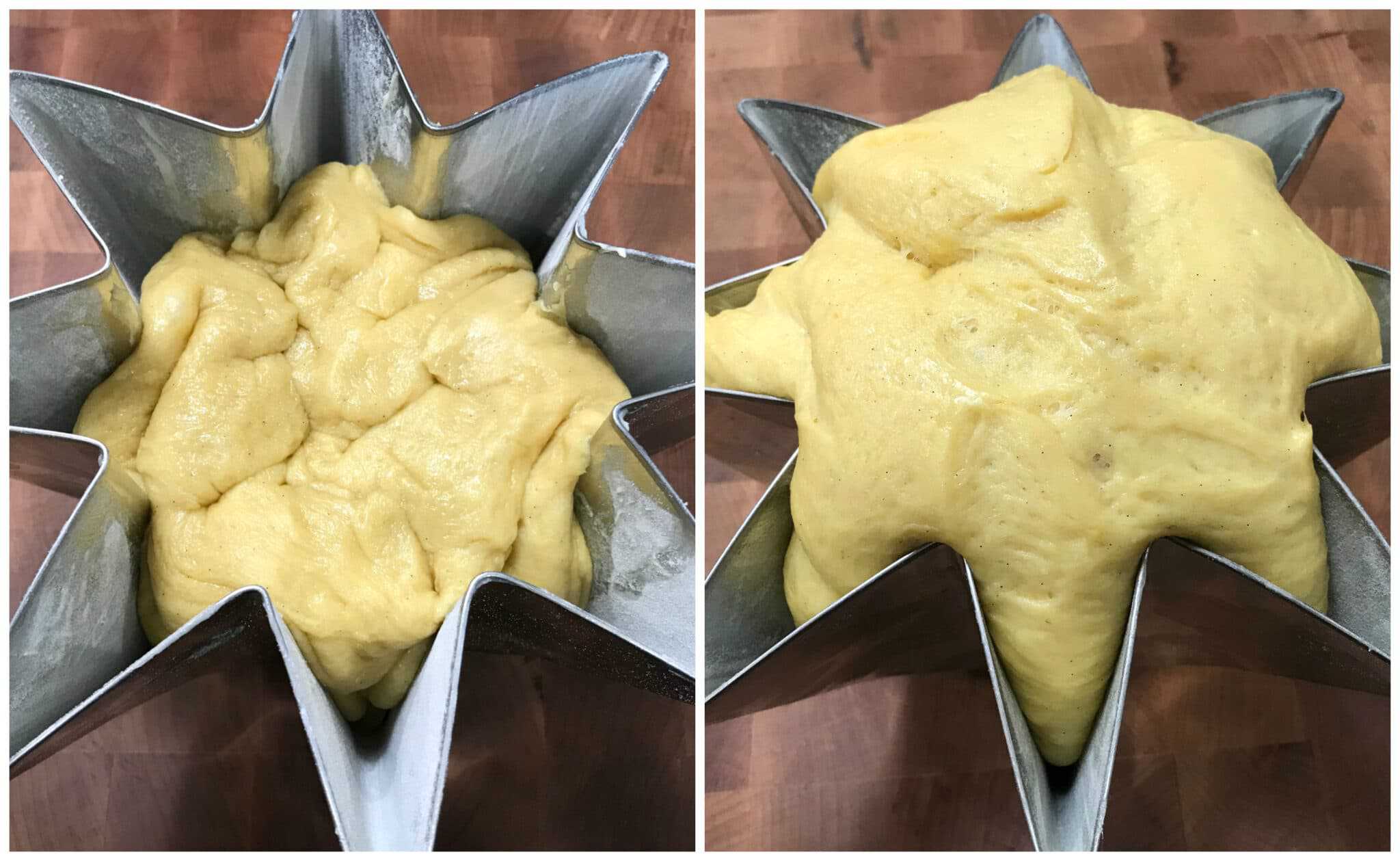
Bake it on the middle rack of an oven preheated to 325 F for 30 minutes.
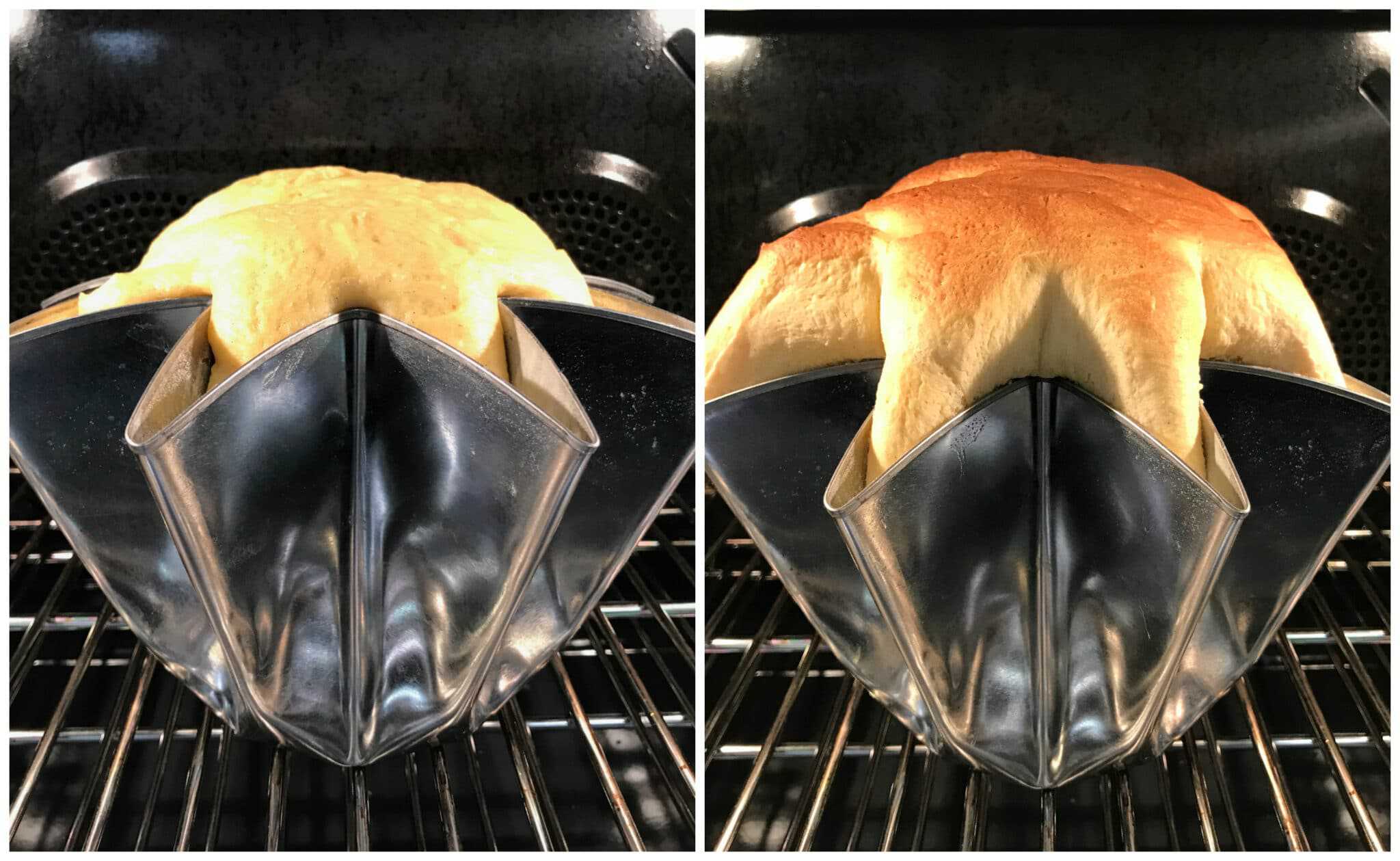
Reduce the temperature to 300 F and bake for another 30 minutes or until the internal temperature reaches 195 F and a toothpick inserted into the middle comes out clean. Be careful not to over-bake or your pandoro will be very dry.
During the baking process if the pandoro begins to brown too quickly cover it with aluminum foil.
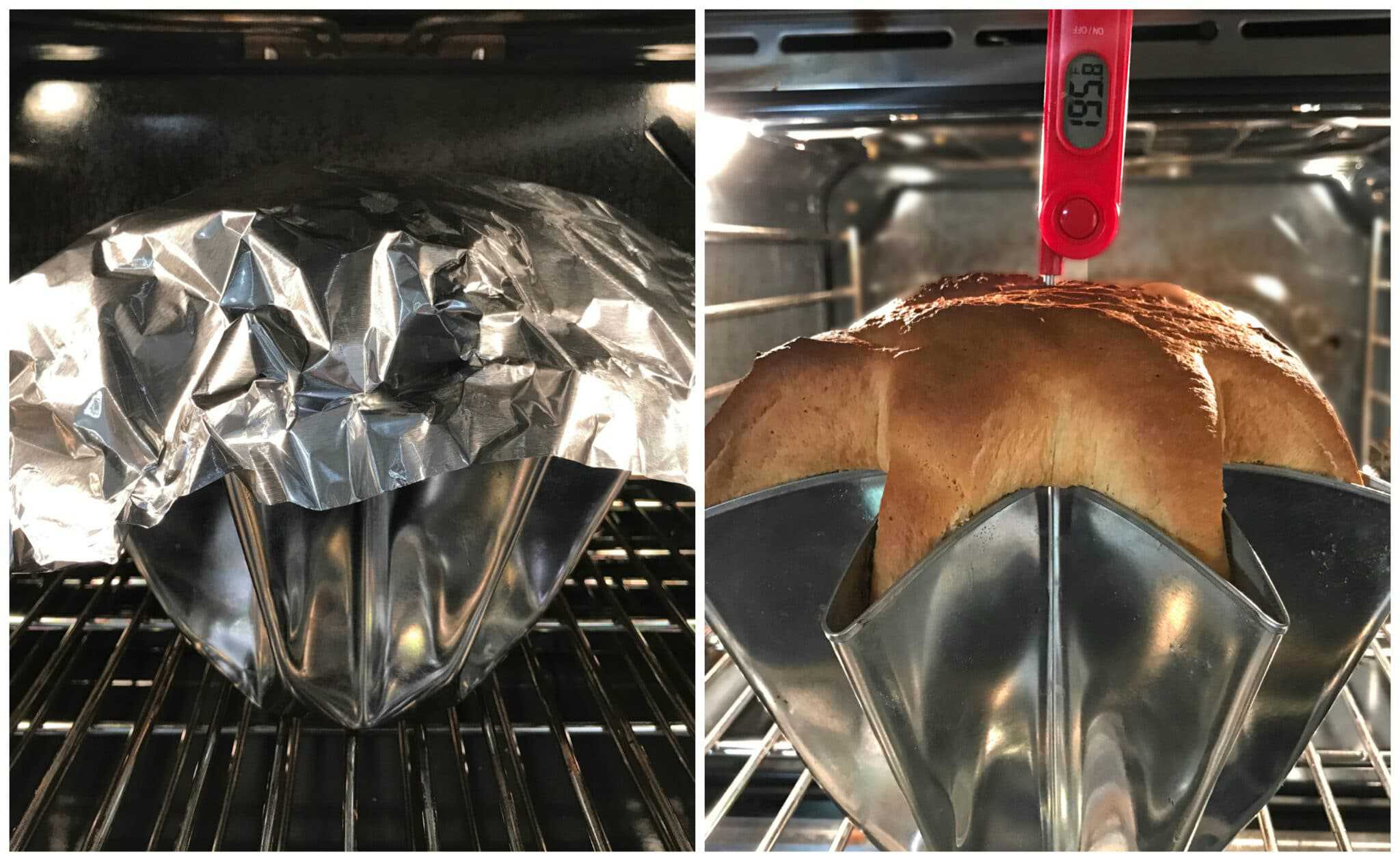
Let the pandoro cool in the mold on a wire rack for 15 minutes and then carefully remove the pandoro from the mold.
Cut a thin layer off the base so it will sit flat on a serving plate.
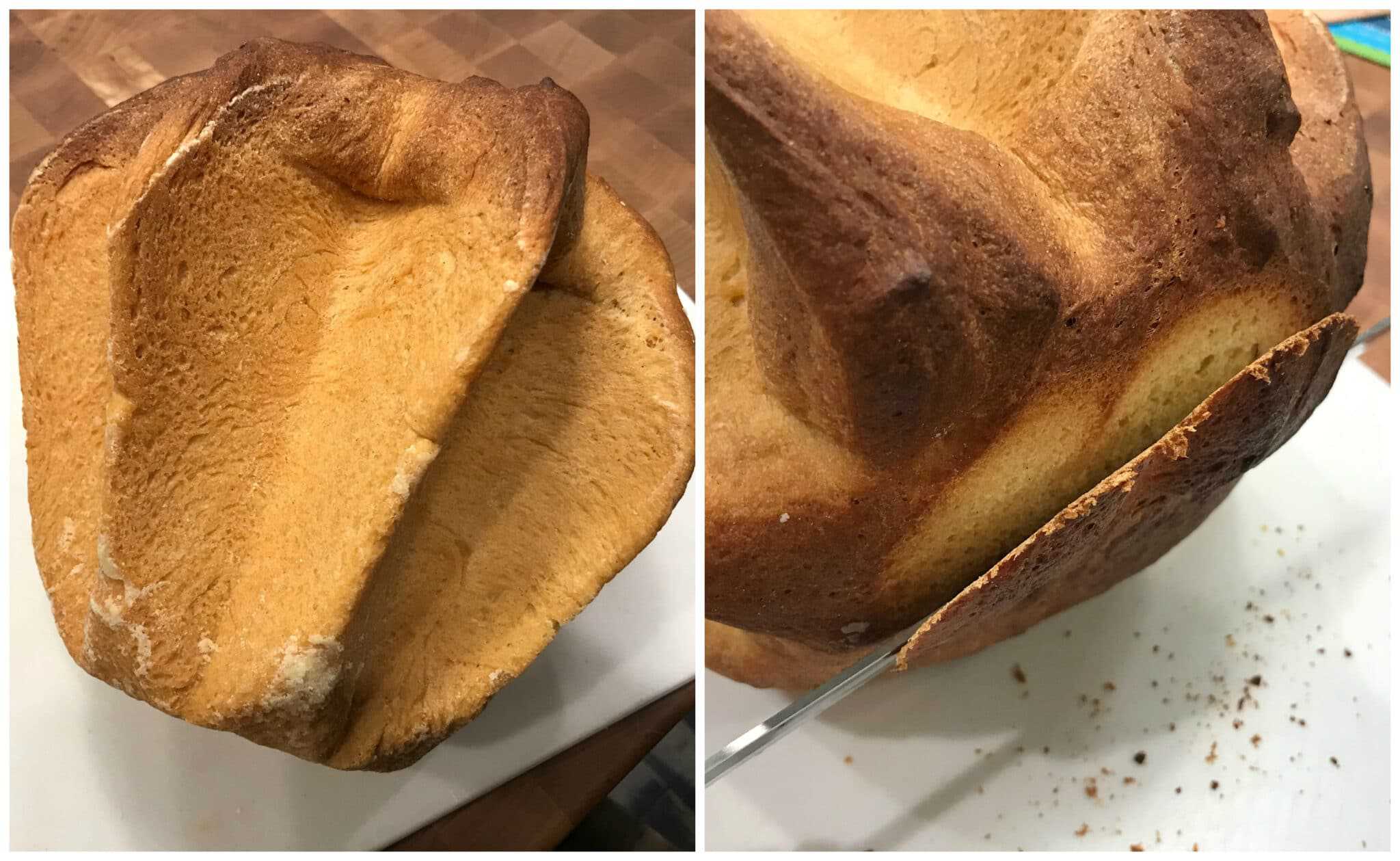
To serve pandoro, once it is cool you can either dust the whole bread with powdered sugar and cut it vertically into slices (traditional).
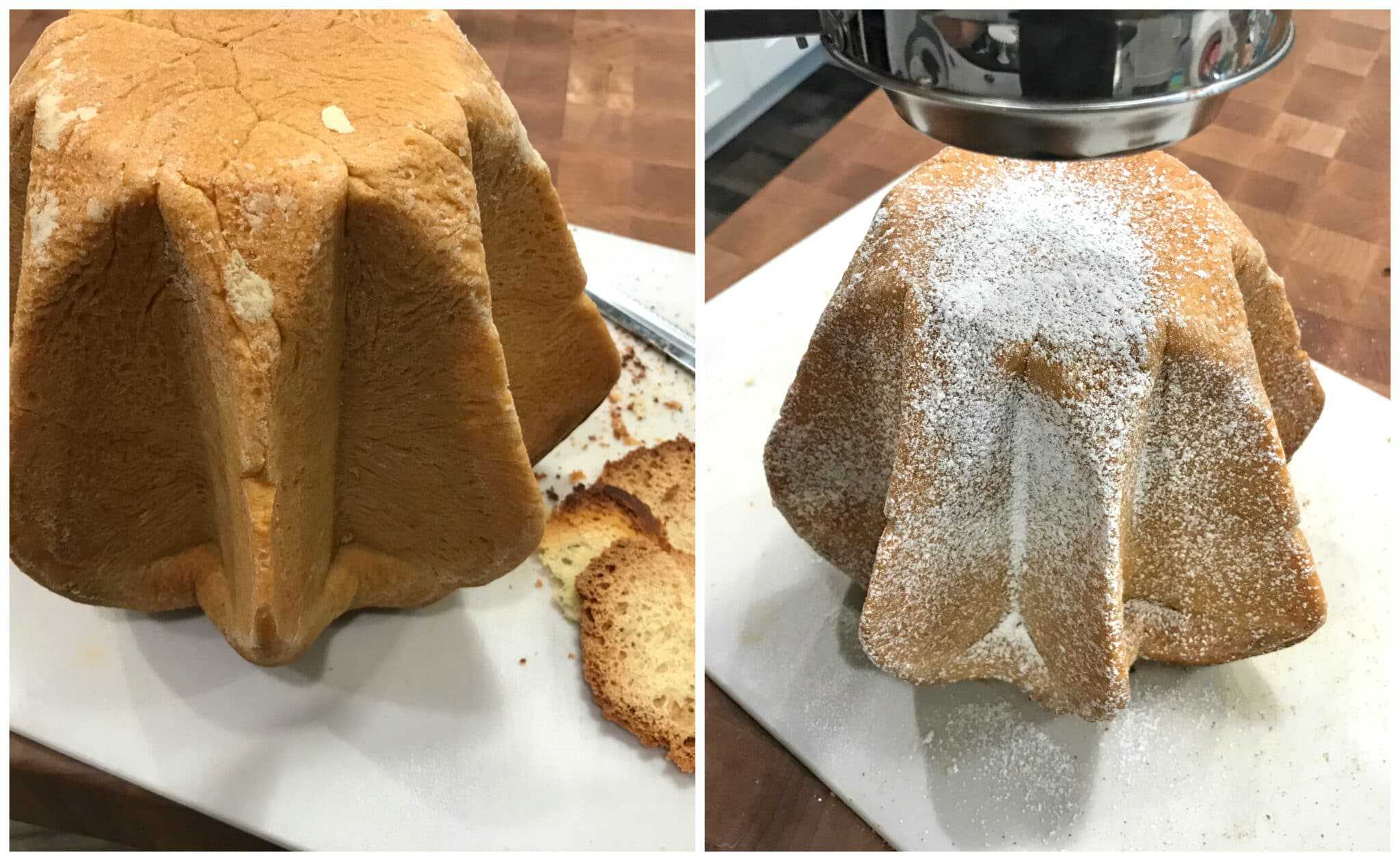
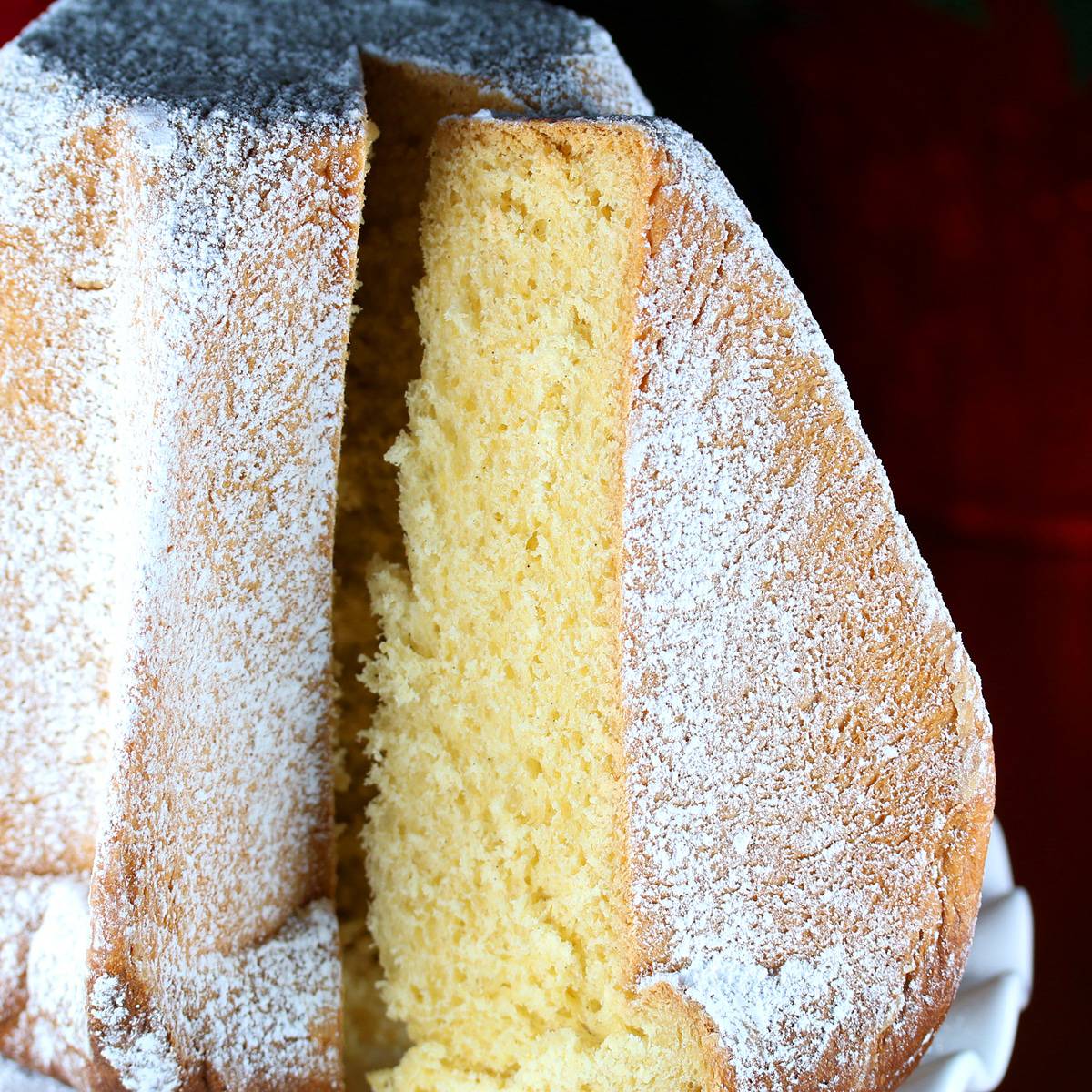
Or for a more interesting look you can slice the pandoro in thick horizontal slices, then rotate the slices. You can then either dust the pandoro with powdered sugar or you can layer each of the horizontal slices with custard, cream, or a filling of choice.
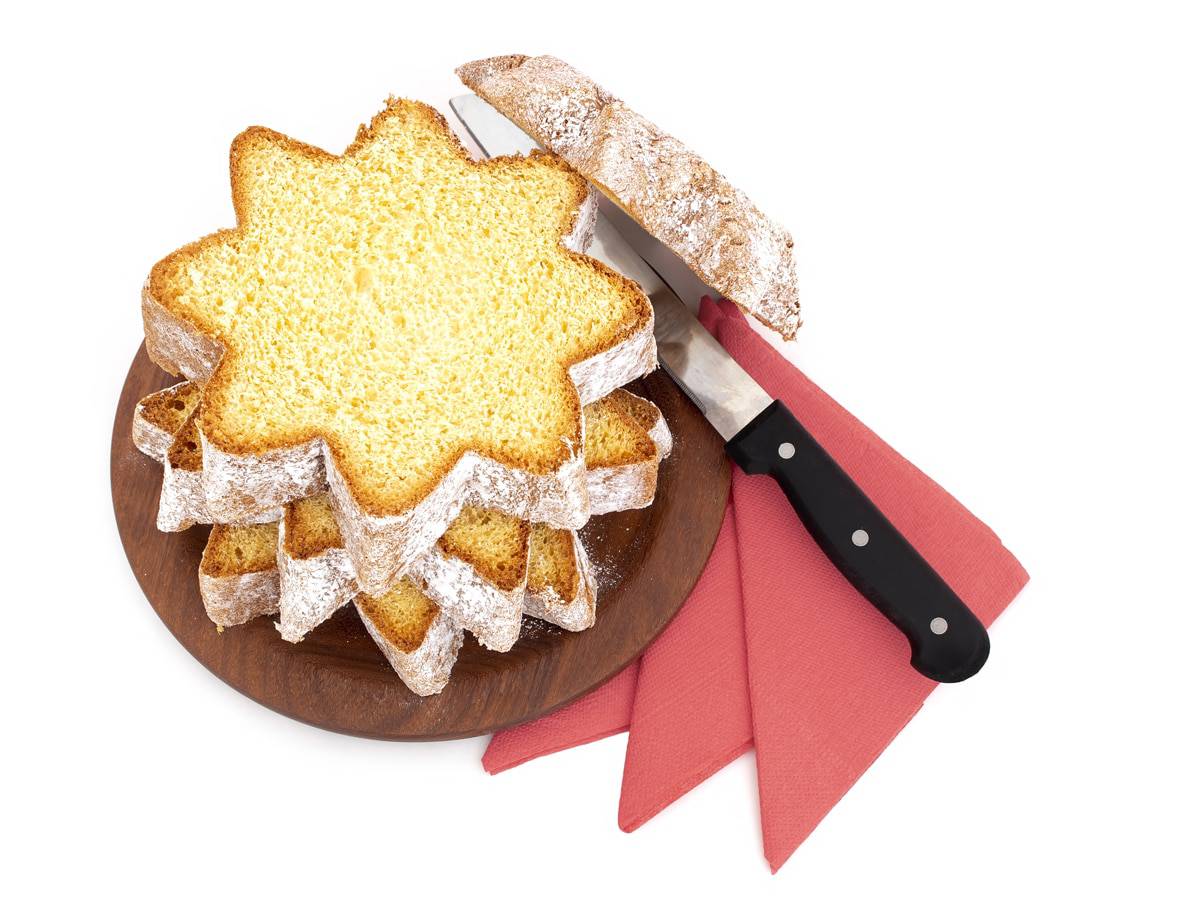
Enjoy!
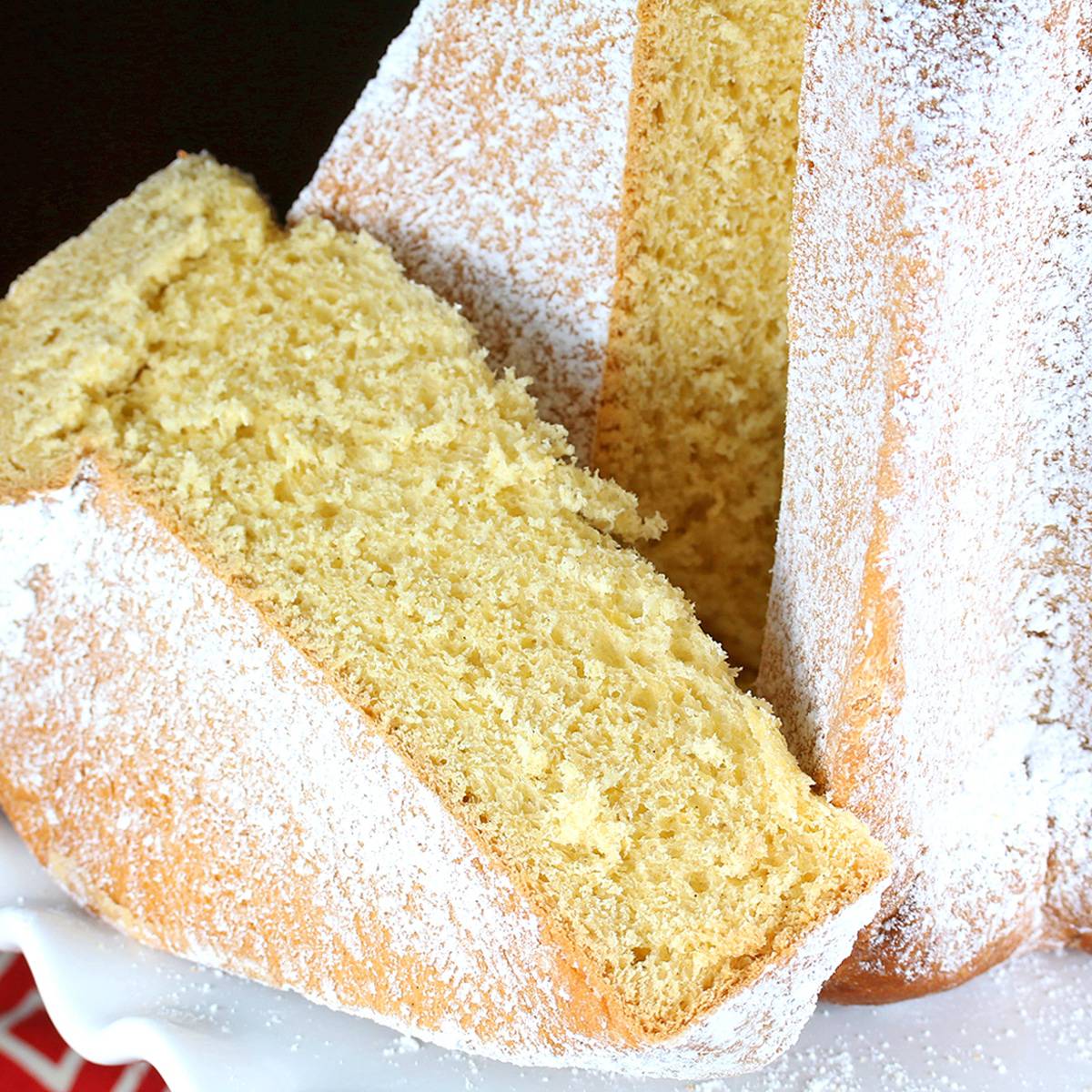
For more traditional Christmas goodies be sure to try my:
- Panettone (Italian Christmas Bread)
- Stollen (German Christmas Bread)
- Pfeffernüsse (German Iced Spiced Cookies)
- Lebkuchen (Nürnberger Elisenlebkuchen)
- Springerle
- Printen (Aachener Gingerbread)
- Speculoos (Gingerbread Shortcrust Cookies)
- Vanillekipferl (Vanilla Crescent Cookies)
- Zimtsterne (Cinnamon Star Cookies)
- Bethmännchen (Marzipan Cookies)
- Heidesand (Browned Butter Shortbread Cookies)
Save This Recipe

Pandoro (Italian Christmas Cake)
Equipment
- Half-size pandoro mold , to make two smaller ones or to halve the recipe and make one smaller one
Ingredients
- For the Starter Dough:
- 1/4 cup plus 1 tablespoon lukewarm water
- 1/2 teaspoon active dry yeast
- 1 teaspoon sugar
- 3/4 cup all-purpose flour
- 1/2 teaspoon salt
- For the Main Dough:
- 1/2 cup lukewarm whole milk
- 2 1/2 teaspoons active dry yeast
- 2 3/4 cup all-purpose flour
- 1/2 cup sugar
- 4 large egg yolks
- 12 tablespoons unsalted butter , softened at room temp
- 2 tablespoons honey
- 2 tablespoons vanilla bean paste (is thicker, has vanilla flecks, and a more intense flavor than vanilla extract but you can substitute 2 TEAspoons of extract if you wish)
- zest of one lemon
Instructions
- Note: If you can't find the classic star-shaped pandoro mold, you can use a 9-cup capacity Bundt or pound cake pan. To make the starter dough: Dissolve the yeast and sugar in the lukewarm water and let it sit for 10-15 minutes until nice and frothy. Place the flour and salt in the bowl of a stand mixer and add the yeast mixture. Using the dough hook, knead the ingredients until they come together. The dough will be smooth but firm and stiff.Form the dough into a ball, place it in a lightly greased bowl, cover loosely with plastic wrap, and let it rise in a warm place for about 2 hours or until nearly doubled in size.Punch it down, form it into a ball, place it back in the bowl, cover tightly with plastic wrap, and place it in the fridge to sit overnight. **Remove the dough from the fridge the next day 2 hours before you're ready to proceed with making the pandoro.
- The next day dissolve the yeast and 1 teaspoon of sugar in the lukewarm milk and let it sit for 10-15 minutes until nice and frothy.Place the flour, sugar, and yeast mixture in the bowl of a stand mixer and mix it together with spoon or with the dough hook. Using the dough hook, add the eggs one at a time, kneading between additions. The mixture will come together into a rich yellow dough.Add the starter dough to the stand mixer. Knead the two doughs together for about 5 minutes. Add the butter, lemon zest, vanilla, and honey and knead for about 10minutes, scraping down the sides of the bowl as needed. The dough should be very smooth and elastic but not overly sticky. If it's too sticky add a little more flour.Form the dough into a ball, lightly spray the bowl, and place the dough back in, loosely covered with plastic wrap, to rise in a warm place for about 3 hours or until nearly tripled in size. Punch the dough down.
- Generously butter a pandoro mold pan getting into all the cracks and crevices. You will need a 9-cup pandoro mold (about 2 liter capacity). Next add some flour to the pan and shake it to thoroughly coat it with flour, shaking out the excess flour. Again, be sure to get into all the cracks and crevices so that your pandoro doesn't stick to the pan.Place the dough into the prepared pandoro mold. Cover loosely with plastic wrap and let it rise in a warm place until the dough has risen to about an inch or so above the top of the mold.In the meantime preheat the oven to 325 F. Bake the pandoro on the middle rack for 30 minutes.Reduce the temperature to 300 F and bake for another 30 minutes or until the internal temperature reaches 195 F and a toothpick inserted into the middle comes out clean. Be careful not to over-bake or your pandoro will be very dry.During the baking process if the pandoro begins to brown too quickly cover it with aluminum foil.Let the pandoro cool in the mold on a wire rack for 15 minutes and then carefully remove the pandoro from the mold.Cut a thin layer off the base so it will sit flat on a serving plate.
- To serve the pandoro, once it is cool you can either dust the whole bread with powdered sugar and cut it vertically into slices (traditional). Or for a more interesting look you can slice the pandoro in thick horizontal slices, then rotate the slices. You can then either dust the pandoro with powdered sugar or you can layer each of the horizontal slices with custard, cream, or a filling of choice.
Originally published on The Daring Gourmet December 3, 2020



















Could I use a Bundt cake pan
Yes you can, Hadley, just make sure it’s one that’s of equal/similar size in terms of cups.
Hi. Can European butter be used in recipe?
Absolutely, Lina!
This cake was beyond delicious. It tasted like a fluffy vanilla cloud. I put my homemade vanilla from my grandmas recipe. Thank you for this recipe.
I’m so happy you enjoyed it, Hadley, and that’s a great way to describe it! Thank you so much!
I made this for the first time last year and it was simply wonderful. I love the flavor of the yeast, vanilla and honey. This cake is so perfect with a cup of coffee. I’ll be making it again this weekend. Thank you for the recipe.
Thank you, Sarah, I’m so thrilled that you enjoyed it! <3
How do I have to do to make this a chocolate pan de oro?
Thank you
Can you fill with a pastry bag some kind of a filling?
I love it!
God bless!
Hi, the simplest way would be add some unsweetened cocoa powder when you add the flour. Depending on how chocolate-y you want it, I’d aim for between 1/2 and 3/4 cup.
Please… cups, tablespoons, etc… give us the QUANTITIES i weight measurmets please.
Hi Tudval, it’s to the right of the ingredients list – just click on “Metric” and it will make the conversions for you.
Reading through the comments…will have to try this…wondering if you could start with a thick sourdough starter?
Also, did you ever make the Bienenstich that one commenter mentioned? I searched your site for a recipe but none found…thanks!
Whoa y’all, this bread is delicious! This was a rainy, stormy day, perfect for a baking project. I’m so glad I tried this. I don’t have a Pandoro mold, but I used a pretty, swirl bundt pan that was the perfect size. It’s not the traditional look, but it is beautiful. Thanks for another successful recipe. I wish I knew how to post a picture here.
That’s wonderful, Pam, I’m so glad you enjoyed it, thank you!
Thank you for posting you did that, I was wondering if I could do it in a bundt!!
I’m very excited to try this! Can I leave the starter dough in the fridge longer than overnight? I can’t continue with the next steps until the next afternoon (rather than morning). Thank you!
Hi Madeline, waiting until the following afternoon is fine. Happy baking!
Just tried this recipe and enjoying the results very much! A delicious, buttery, vanilla and lightly lemon scented bread. Beautiful texture too. My question is, what’s the best way to store it after it is baked (without freezing) and how long will it keep? I’d like to make some for Christmas gifts but dont want to make them too far in advance for them to go stale. Thanks for the recipe!
Wonderful, Victoria, thank you so much! To store it wrap it very well and plastic wrap and keep it in an airtight container. It will keep at room temperature for about 5 days.